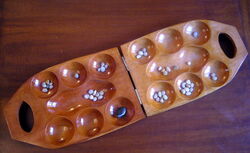Mr Mancala (talk | contribs) (New page: {| align=right border=1
|'''Warri'''
|-
|''Other Names:'' Kay (?)
|-
|''First Description:'' Suzanne<br/>Comhaire-Sylvain, 1952
|-
|''Cycles:'' One
|-
|''Ranks:'' Two
|-
|''Sowi...) |
Mr Mancala (talk | contribs) m (Protected "Warri (Haiti)" ([edit=autoconfirmed] (indefinite) [move=autoconfirmed] (indefinite))) |
||
| (11 intermediate revisions by 3 users not shown) | |||
| Line 1: | Line 1: | ||
| + | ''Warri → [[Kay|French]].'' |
||
| + | |||
| + | |||
{| align=right border=1 |
{| align=right border=1 |
||
|'''Warri''' |
|'''Warri''' |
||
|- |
|- |
||
| − | |''Other Names:'' |
+ | |''Other Names:'' Caille, Kay |
|- |
|- |
||
|''First Description:'' Suzanne<br/>Comhaire-Sylvain, 1952 |
|''First Description:'' Suzanne<br/>Comhaire-Sylvain, 1952 |
||
| Line 21: | Line 24: | ||
Warri was first described in 1952 by [[Suzanne Comhaire-Sylvain]] (1898-1975), the first anthropologue of Haiti. She researched mancala games on Haiti and in the Democratic Republic of the Congo (see [[Mangola (traditional)|Mangola]]). |
Warri was first described in 1952 by [[Suzanne Comhaire-Sylvain]] (1898-1975), the first anthropologue of Haiti. She researched mancala games on Haiti and in the Democratic Republic of the Congo (see [[Mangola (traditional)|Mangola]]). |
||
| + | [[Image:Kay jeu.jpg|thumb|250px|Warri board]] |
||
Comhaire-Sylvain claimed that Warri is called '''Kay''' ("house") in southern Haiti according to some informants she interviewed in the early 1950s. However, Haitians who were interviewed in 2004 by Víktor Bautista i Roca in the Dominican Republic and in 2006 in Switzerland said that the game of ''Kay'' in southern Haiti is similar to [[Hoyito]]. |
Comhaire-Sylvain claimed that Warri is called '''Kay''' ("house") in southern Haiti according to some informants she interviewed in the early 1950s. However, Haitians who were interviewed in 2004 by Víktor Bautista i Roca in the Dominican Republic and in 2006 in Switzerland said that the game of ''Kay'' in southern Haiti is similar to [[Hoyito]]. |
||
== Rules== |
== Rules== |
||
| ⚫ | |||
| ⚫ | |||
| ⚫ | |||
| − | |||
| ⚫ | |||
[[Image:Waurieini.jpg]] |
[[Image:Waurieini.jpg]] |
||
| Line 56: | Line 59: | ||
==Copyright== |
==Copyright== |
||
| − | ''© Wikimanqala.<br /> |
+ | ''© [[Wikimanqala]].<br /> |
| − | By: Víktor Bautista i Roca.<br /> |
+ | By: [[Víktor Bautista i Roca]].<br /> |
| − | Under the [http://creativecommons.org/licenses/by-sa/2.5/ CC by-sa 2.5]. |
+ | Under the [http://creativecommons.org/licenses/by-sa/2.5/ CC by-sa 2.5]. |
| − | |||
[[Category:Traditional_Mancala_Games]] |
[[Category:Traditional_Mancala_Games]] |
||
[[Category:North_America]] |
[[Category:North_America]] |
||
Latest revision as of 10:01, 2 December 2020
Warri → French.
| Warri |
| Other Names: Caille, Kay |
| First Description: Suzanne Comhaire-Sylvain, 1952 |
| Cycles: One |
| Ranks: Two |
| Sowing: Multiple laps |
| Region: Haiti |
Warri is the most popular mancala game played in the northern part of Haiti. It is named after the bush of which the seeds are used in play.
Adults play Warri on wooden boards, which have a large hole at each end to store the captured seeds. Children, both boys and girls, dig the boards in the ground.
Warri was first described in 1952 by Suzanne Comhaire-Sylvain (1898-1975), the first anthropologue of Haiti. She researched mancala games on Haiti and in the Democratic Republic of the Congo (see Mangola).

Warri board
Comhaire-Sylvain claimed that Warri is called Kay ("house") in southern Haiti according to some informants she interviewed in the early 1950s. However, Haitians who were interviewed in 2004 by Víktor Bautista i Roca in the Dominican Republic and in 2006 in Switzerland said that the game of Kay in southern Haiti is similar to Hoyito.
Rules
The Warri board has two rows of six holes. Each player controls one row.
At the beginning each hole contains four seeds.
Initial Position
Players take turns to move.
At his turn a player takes (ramasse) all the seeds from one of his holes, which has at least two seeds, and then sows them anti-clockwise, one by one, into the following holes.
A player may also start his move from a hole with a single seed if it is followed by one and only one empty hole. In this case, he just transfers this single seed to the empty hole.
If the last seed falls in an occupied hole (couvert) that is not followed by an empty one all these seeds (the one just sown and those which were already there) are picked up and distributed in another lap.
If the last stone is dropped in an opponent's hole increasing its contents to four pieces, the player shouts Kay! (literally "house"). He then captures its contents (mange le couvert) and also the contents of an unbroken sequence of preceding holes as long as they belong to his opponent and contain four seeds.
When the last stone lands in a couvert followed by an empty hole, the move ends.
When the last stone falls in an empty hole, it is transfered to the next couvert and the move stops.
The game ends when a player can't move because all the holes are empty, or contain just a single seed, which isn't followed by one and only one empty hole.
The winner is the player who has captured more kay.
References
- Comhaire-Sylvain, S.
- Jeux Congolais. In: Zaire: Revue Congolaise (Bruxelles) 1952; 6 (4): 351-362.
Copyright
© Wikimanqala.
By: Víktor Bautista i Roca.
Under the CC by-sa 2.5.
